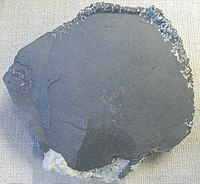Minerals/Metalloids
Metalloids are elements whose properties are intermediate between metals and solid nonmetals or semiconductors.

A variety of elements are often considered metalloids:
- boron, considered here in the boronides,
- aluminum, a face-centered cubic metal, considered in the aluminides,
- silicon, here in the siliconides,
- gallium (it can occur in the liquid state as a mineraloid),
- germanium,
- arsenic,
- selenium, also included in the chalcogens,
- cadmium,
- indium,
- tin,
- antimony,
- tellurium, also included in the chalcogens,
- polonium, considered as among the heavy metals and
- astatine, here is with the halogens.
Minerals
editEach of the metalloids, in the native or elemental form has at least one crystal structure, but these structures may not be the usual cubic structures: face-centered cubic or body-centered cubic that metals often occur in.
Galliums
editWhile native gallium would be the best source of gallium, it apparently does not occur on Earth.
Gallite (CuGaS2) is 25 at % gallium.
Germaniums
editThe sample of germanite on the right has a composition of Cu26Fe4Ge4S32. Generally, germanite has a composition closer to Cu3(Ge, Ga, Fe, Zn) (S,As)4.[1] "This sample also contains tennantite."[2]
Arsenics
editNative arsenic such as in the image on the right and at the top of this resource occurs in silver ore veins.
Allemontites
editAllemontite is a native alloy of arsenic and antimony, with a composition of AsSb.[1]
The first example on the right is from the mineral collection of Brigham Young University Department of Geology, Provo, Utah.
The second is from Příbram, Central Bohemia Region, Bohemia (Böhmen; Boehmen), Czech Republic.
As a natural source of arsenic, it has 50 at % arsenic.
Seleniums
editOn the right is a photograph of native selenium from the mineral collection of Brigham Young University Department of Geology, Provo, Utah.
The second image down on the right shows dark gray selenium in sandstone from Westwater Canyon Section 23 Mine Grants, New Mexico.
Indiums
editOn the right are microprobe fragments of native indium from Eastern Transbaikal, Russia. The electron microprobe confirms that indium is the only component of the metallic phase.
Tins
editNative tin such as in the images on the right occurs in two crystal forms: α-Sn (cubic) and β-Sn (tetragonal).[1]
Antimonies
editNative antimony such as occurs in the rock on the upper right with its various oxidation products is crystalline in the hexagonal system.
The second image shows hexagonal crystals with metallic luster.
Telluriums
editOn the right is an example of native tellurium from the Emperor Mine, Vatukoula, Tavua Gold Field, Viti Levu, Fiji.
Hypotheses
editSee also
editReferences
edit- ↑ 1.0 1.1 1.2 Willard Lincoln Roberts; George Robert Rapp Jr.; Julius Weber (1974). Encyclopedia of Minerals. New York, New York, USA: Van Nostrand Reinhold Company. pp. 121-2. ISBN 0-442-26820-3.